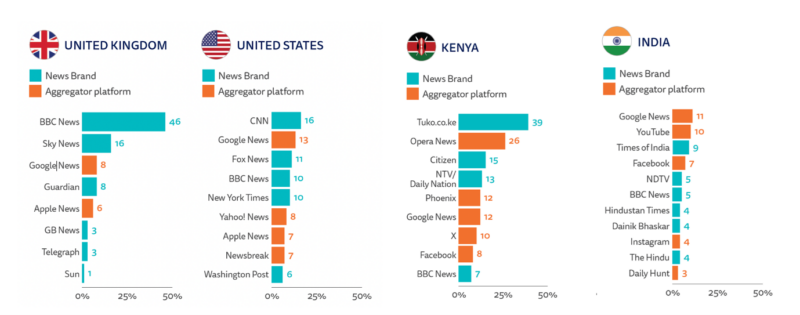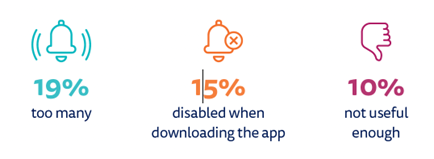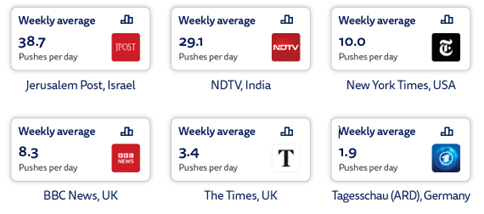
Do you get too many mobile news alerts? Are they always relevant or well judged? Have you thought about unsubscribing or deleting the app as a result?
If this feels familiar then you aren’t alone. Our research shows that many consumers have a love-hate relationship with news notifications and publishers are constantly walking a tightrope as they try to build frequency without unduly irritating or distracting their most loyal customers.
Over the last decade, smartphones have become the most frequently used device for accessing news in the UK but getting attention amid the cacophony of competing options remains an enormous challenge. Even if publishers can persuade someone to download an app, it is another story to convert this into regular usage. That’s where notifications come in, but what strategies are working and which brands are benefitting most?
Data from our Reuters Institute Digital News Report shows that the proportion using mobile news alerts weekly has grown significantly in the UK from 3% in 2014 to 18% in 2025 (6% to 23% in the United States). But most of this growth happened before 2017 and has slowed considerably as the battle for attention on the lockscreen has intensified.
In our latest survey we asked respondents which news organisations – or aggregators – they most often received alerts from. In many countries, including the UK, we find that brands that are well trusted and have a reputation for breaking news tend to perform best – and that tends to be those with a broadcast legacy.
BBC News has the most widely domestically installed news app and the brand was mentioned by almost half (46%) of respondents who get news alerts, around three times as many as second-placed Sky News. This is the equivalent of around 4% of the adult population, suggesting that almost 4 million people in the UK will be notified every time the BBC sends an alert, which would make it one of the most powerful digital channels in its armoury.
“They alert me to big news stories unfolding throughout the day, even when I’m too busy to sit and read or watch the news”
Female survey respondent, 34, UK
In the United States we find a more fragmented landscape, with broadcast brands CNN and Fox News near the top of the list along with The New York Times, but it is also striking to see that more of the alerts come from aggregator or platform brands.
In addition to Google and Apple News, Yahoo! retains a strong position in the US, while Newsbreak is a relatively new app that has aggressively used personalised (AI-driven) alerts to drive growth. Many survey respondents stressed the convenience of how the news now ‘comes to them’ in a timely way, supplementing existing usage patterns.
They bring information regarding news events happening in real-time [even] when I’m not watching news. Male, 57, USA
Proportion of news alert users that regularly get alerts from each brand (select countries)

But elsewhere we see different patterns. In global majority countries such as Kenya and India more alerts tend to be delivered by aggregators or platforms. In Kenya, Opera News plays a major role while in India, Google and YouTube alerts were mentioned more often than traditional brands such as NDTV and the Times of India.
This reflects heavy platform-based consumption in these countries with algorithms generating automated alerts based on previous usage of particular subjects.
Too many alerts can put people off
Mobile alerts are not universally loved. Indeed, the vast majority of our survey respondents (79% in aggregate) say they do not get any news alerts during an average week.
Across countries, more than four in ten (43%) of those that do not get alerts say they actively disabled them – either because they feel they get too many or because they are not useful: “They annoyed me so I turned them off”, said one respondent, while others were more concerned about the depressing nature of the news itself.
“I turned off all my news apps and sites after Trump was elected”, said one liberal respondent from the United States, while another added “I have switched off notifications again because it’s emotionally distressing”.
There is a clear link here with more general news avoidance trends – with those who say they “often avoid” the news less likely to sign up in the first place and more likely to disable them later.
Proportion of non-alert users that gave each as a reason

Respondents also found alerts could be frustrating in other ways: “Sometimes the headlines are misleading when you select the article. Sometimes you have to pay to view the content, especially on Apple News”, said one UK respondent (male, 42).
Publishers are extremely conscious of the tightrope they are walking when sending news alerts. Most have strict limits on the number they send each day and clear criteria about the type of alerts as well as the best time to send them.
The Times of London, for example, sends no more than four each day, conscious that more frequent alerts can lead to a spike of those uninstalling the app. The Financial Times sends a number of general news alerts to all and then for those that opt in, a personalised notification at around 5pm each day based on a subscriber’s particular interests, as well as a morning briefing alert. At the weekend there is promotion of longer reads and relaxed features.
Some publishers have developed additional cues such as reading time, or graphical elements to help them stand out


Analysis shows that BBC News in the UK will typically send up to ten alerts each day. These mostly deal with breaking stories of national or international importance, with many containing a link to a live video feed or live blog to encourage further consumption.
At times the BBC also uses its notification service to promote an exclusive feature, investigation, or piece of analysis, though this wider remit is not always welcomed: “I value news alerts that are truly breaking news rather than just everyday stories seeking clicks”, said one UK survey respondent.
[Read more: Analysis of BBC News push notifications about 2024 general election]
But not all publishers are so restrained. The Jerusalem Post and CNN Indonesia typically send up to 50 alerts each day and some aggregator apps will send even more.
Average number of push alerts by publisher (selected)

It may be that in some countries where news remains highly prized, there is a tolerance for a higher number of alerts but tech companies that run mobile operating systems such as Apple and Google have routinely warned publishers about sending too many.
Apple has started to group messages together and even to summarise duplicative ones using AI, though this feature was withdrawn after a number of mistakes.
Despite this, publishers worry that platforms could further restrict or mediate their notifications in the future – or prioritise their own aggregation services over direct messages from news brands.
The pressure for attention is likely to intensify further with AI bots and agents adding to the noise and news organisations will need to be even smarter in how and when they use alerts to keep users engaged without causing them to unsubscribe.
Our research shows that audiences want more personalised and relevant content but they also don’t want to miss out on important national and international news. Some users just want breaking news, others are happy to be alerted about lighter stories or specialist news.
Striking the right balance will require a deeper understanding of these very different audience needs – and then varying the content, the format, and the time of day accordingly.
Moving away from using push alerts as a blunt instrument and providing more personal choice and control could yet help publishers sustainably grow engagement on their critical mobile platforms.
Email pged@pressgazette.co.uk to point out mistakes, provide story tips or send in a letter for publication on our "Letters Page" blog
